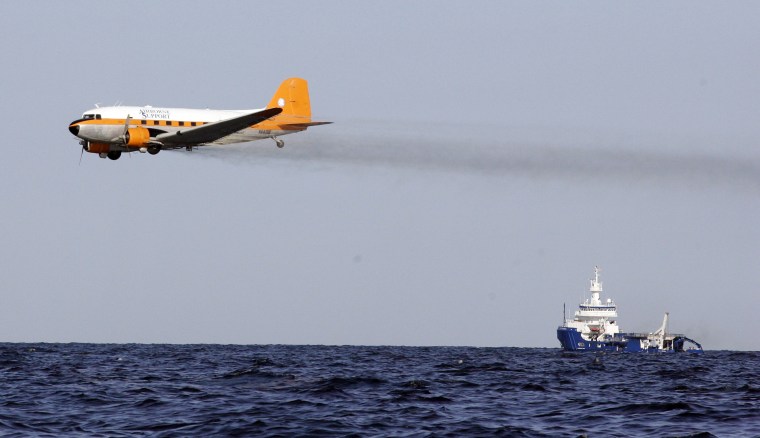A massive oil leak in the Gulf of Mexico has become the testing ground for a new technique where a potent mix of chemicals is shot deep undersea in an effort to stop oil from reaching the surface, and scientists are hurriedly weighing the ecological risks and benefits.
Crews battling the spill already have dropped more than 156,000 gallons of the concoction — a mix of chemicals collectively known as "dispersant" — to try to break up the oozing oil, allowing it to decompose more quickly or evaporate before washing ashore.
The technique has undergone two tests in recent days that the U.S. Coast Guard is calling promising, and there are plans to apply even more of the chemicals. But the effect of this largely untested treatment is still being studied by numerous federal agencies, and needs approval from a number of them before it can be rolled out in a larger way.
"Those analyses are going on, but right now there's no consensus," said Charlie Henry, the scientific support coordinator for the National Oceanic and Atmospheric Administration. "And we're just really getting started. You can imagine it's something we've never thought about."
Chemical dispersants carry complex environmental trade-offs: helping to keep oil from reaching sensitive wetlands while exposing other sea life to toxic substances. The concoction works like dish soap to separate oil and water, but the exact chemical composition is protected as a trade secret.
The use of chemicals to break up the oil is just one of many techniques being used to try to prevent as much of the slick as possible from reaching land and contaminating sea life in the Gulf of Mexico since an oil rig exploded April 20 and collapsed, killing 11 workers and posing a hazard to a fragile ecosystem.
The undersea well has been spewing 200,000 gallons a day since the explosion aboard the drilling rig Deepwater Horizon. BP PLC, the operator of the rig, has been unable to shut off the well, but crews have reported progress with using chemicals to reduce the amount of oil that reaches the surface.
During a test over the weekend, the dispersant was shot into the well at a rate of 9 gallons per minute, according to authorities. About 3,000 gallons total were dispensed during the experiment.
More than 230,000 gallons of dispersant is available, and more is being manufactured by Nalco Company of Naperville, Illinois, for use in the Gulf. Neither Nalco, BP, rig owner Transocean Ltd or the Coast Guard have specified how much of the chemical brew will be needed to handle this spill.
Corexit 9500 used
One of the chief agents being used, called Corexit 9500, is identified as a "moderate" human health hazard that can cause eye, skin or respiratory irritation with prolonged exposure, according to safety data documents.
According to the company, Corexit contains no known carcinogens or substances on the federal government's list of toxic chemicals.
Even some of the most ardent environmentalists, while concerned about the potential effects, aren't suggesting that the chemical concoction shouldn't be used in this case.
"It's basically a giant experiment," said Richard Charter, a senior policy adviser with Defenders of Wildlife. "I'm not saying we shouldn't do it; we have no good options."
Coast Guard Rear Adm. Mary Landry, the federal on-scene coordinator, called the tests so far "very promising, very promising." Sonar and camera images from the first test last week appeared to show a reduction in oil on the surface, although federal officials said they want more information from planes that will examine the leak site from the air.
If deep water spraying is approved, Landry said crews would scale back their use of dispersant on the ocean surface, except to treat pockets of oil that escaped the well before the undersea injections started.
Ingredients proprietary
Corexit is included on the U.S. Environmental Protection Agency's official list of products that can be used to fight spills in an emergency. To qualify for the list, manufacturers must complete specific tests to demonstrate a chemical's effectiveness, ingredients and aquatic toxicity. Charles Pajor, a Nalco spokesman, declined to provide the ingredients for Corexit, saying that was proprietary. The company's website says the agent has "low toxicity" and is "biodegradable."
Environmental tests on Corexit indicate it can be stored in the tissue of organisms, or bioaccumulate, and that more than half of the agent in tests wound up storing in sediment, with less absorbing into the water and a smaller amount evaporating into the air.
Even so, Corexit is classified as having a "low" potential environmental hazard.
Such chemicals have been used for decades to break up oil slicks, including the 11 million gallons dumped in the Exxon Valdez spill in 1989, but federal officials say they have not been used at such a great depth, and do not understand the short-or long-term effects on life on the sea floor or in the water column.
When used on the surface, dispersants remove oil from where birds, turtles and other sea creatures could eat it or breathe in the poisonous fumes. Marine scientists say they also keep the oil balls suspended in the water, where they are eventually consumed by bacteria, which can pass toxins up the food chain.
"They're talking about using dispersants in the deep water where the oil is coming out that would prevent it from hitting shore, but would actually put it into the water column and possibly force it to the bottom of the ocean," said Cynthia Sarthou, executive director of the New Orleans-based Gulf Restoration Network.
"The environmental impact of that is totally unknown. It could end up killing everything at the bottom of the ocean."
